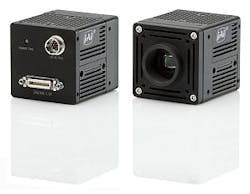JAI cameras combine four taps to provide high-speed readout
The AM-200CL (monochrome) and AB-200CL (color) cameras provide resolution of 1600 × 1200 pixels with a standard acquisition rate of 68 frames/s. The cameras use the quad-tap architecture of the KAI-02050 CCD sensor for image acquisition then combine the four taps into two for high-speed monochrome or raw Bayer readout. To simplify integration, the two taps are multiplexed via an 80-MHz data clock to deliver 8-, 10-, or 12-bit output over a single-cable Camera Link Base configuration. The AB-200CL color model can also perform in-camera color interpolation, producing 24-bit RGB output at 34 frames/s in the same configuration.
JAI Inc.
San Jose, CA, USA
-- Posted by Vision Systems Design
View More New Products
---
NEW PRODUCT PRESS RELEASE
JAI rolls out two more 2-megapixel quad-tap cameras
SAN JOSE, CA - JAI has added two more 2-megapixel industrial grade cameras to its line of advanced quad-tap models which offer high resolution and CCD-quality images at faster frame rates than typical CCD cameras.
The new AM-200CL (monochrome) and AB-200CL (color) cameras provide a resolution of 1600 x 1200 pixels with a standard frame rate of 68 fps. The cameras use the quad-tap architecture of the KAI-02050 CCD for rapid image acquisition then combine the four taps into two for high-speed monochrome or raw Bayer readout. To simplify integration, the two taps are multiplexed via an 80 MHz data clock to deliver 8-bit, 10-bit, or 12-bit output over a single-cable Camera Link base configuration.
Alternatively, the AB-200CL color model can also perform in-camera color interpolation, producing 24-bit RGB output at 34 fps. Again, this output is delivered via a simple, one-cable Camera Link base configuration.
Like the previously introduced JAI quad-tap cameras, these new models provide high performance with outstanding image fidelity, thanks to an advanced automatic channel balancing algorithm that continuously adjusts gain and offset of the individual channels to produce a full resolution image with virtually undetectable boundaries between the tap areas.
The cameras feature user configurable AOI scanning (partial scanning), multiple binning modes (AM-200CL only), and a variety of acquisition modes, including continuous, single-frame, and multi-frame capture, plus a separate PIV mode. Advanced image pre-processing features range from auto-gain, auto-shutter, and auto-white balancing, to pixel blemish compensation, flat-field compensation, and a 256-point look-up table for gamma customization.
Like JAI’s other high resolution cameras, which now number over 24 models between 2- and 16-megapixels, the new 2-megapixel models incorporate a list of industrial grade features to maximize performance in machine vision environments. These include precise sensor alignment, advanced thermal management, a built-in temperature sensor, and rugged construction with extensive shock and vibration testing performed.
The AM-200CL and AB-200CL cameras support C-mount lenses. Dimensions are 55 mm wide and 55 mm high by 69 mm in length.
About the JAI Group
JAI is a manufacturer of high quality, industrial-grade cameras for the machine vision, transportation, aerospace, homeland security, medical and scientific markets.
JAI’s broad product line features high performance progressive scan CCD cameras with spatial resolutions from VGA to 16 megapixels; traditional interlaced video cameras; intensified cameras with sensitivity to light levels as low as .00001 lux, and a range of innovative 2CCD and 3CCD prism-block cameras including both area scan and line scan models.
Physical interfaces include the Camera Link and GigE Vision high performance digital standards, as well as both TV-standard and analog progressive scan output.
JAI cameras help improve customer businesses in a variety of ways, whether by improving quality and accuracy, lowering costs, increasing yields, or simply enabling better service. In addition to cameras, JAI’s traffic solutions group is one of the world’s leading manufacturers of specialized traffic systems. Solutions are based on JAI-developed hardware and software, which is often integrated with third-party products.
SOURCE: JAI
